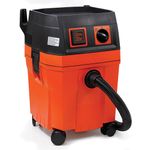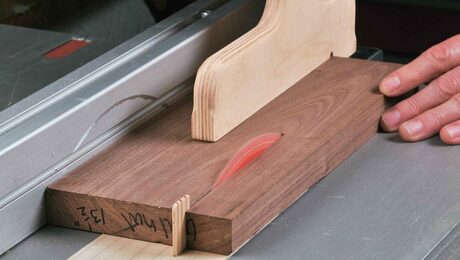Woodworkers are often already aware of the common hazards of the craft, but what they may be missing are hidden dangers in woodworking. These include wood dust, sap and oils, mold and fungus, chemical additives, toxic solvents and adhesives, vibration, and noise.
This article, originally published in the Winter 1977 issue of Fine Woodworking describes respiratory ailments, skin irritations, allergies, toxic woods, vibration disease, noise damage, fire hazards, preventive measures, and information campaigns that strive to educate craftsmen of these dangers.
Health hazards in woodworking
Industrial woodworkers have long recognized the risks of their trade. But it has been only in the past few years that artists and craftsmen have become concerned about—or even aware of— the many hidden dangers in woodworking.
Of course everyone recognizes those hazards that cause immediate and traumatic injury–blades that cut fingers and limbs, wood chips and fragments that fly into eyes, loose clothing or long hair that catches in whirling machinery, smashed fingers and toes, muscle strains from heavy lifting. But now medical authorities in the United States, Canada and England cite a number of insidious causes of disease that can be directly attributed to woodworking. Their list includes wood dust, sap and oils, mold and fungus, chemical additives, toxic solvents and adhesives, vibration and noise.
| MORE ON SAFETY |
| Toxic Woods Find out which woods cause allergic, toxic, infectious, or respiratory reactions |
|
 |
Preventive Safety Measures for Woodworkers Modify your shop habits to avoid woodworking hazards |
A diligent search of medical literature, or a chat with an industrial hygiene specialist, will turn up dozens of horror stories about the health hazards of woodworking. For example, the 43-year-old woodworker who had operated a lathe for more than 25 years and became worried about a persistent sinus irritation and sore throat. His doctor prescribed a standard treatment, yet the condition did not improve. Finally, lab tests revealed cancer of the nasal passages. Or the art student who broke out in a rash, with blisters resembling second-degree burns, shortly after she began to sculpt wood. When she stopped woodworking, her skin healed.
The mere existence of a medical case history doesn’t mean every woodworker will succumb to serious disease; the biggest unknown is often the size of the risk. In most cases, woodworkers can take adequate precautions for relatively little cost. Common protective measures are described in the box on page 56. Woodworkers who notice something wrong with their health would be wise to suspect something in the shop; some potential problems are discussed below.
Respiratory ailments Health authorities warn that woodworkers should be most on guard against inhaling foreign substances.
Health authorities warn that woodworkers should be most on guard against inhaling foreign substances.
To most woodworkers, concern about the cancer-causing potential of wood dust overrides all other health worries. Indeed, this concern appears justified, at least on the surface. Woodworkers are 500 times more likely to have certain types of nasal cancer than non-woodworkers. However, the risk of developing cancer solely through exposure to wood dust is quite low.
“The statistics on cancer in woodworkers can be made to sound quite alarming,” says Dr. Julian A. Waller of the University of Vermont Medical School and an authority on health hazards in the arts. “But the actual risk advances only from ‘extremely rare’ to ‘rare.’ Only one woodworker in 1,400 will get this cancer, and at that after an average of 40 years of exposure.”
Nevertheless, in various health hazard evaluations conducted by the National Institute of Occupational Health and Safety (NIOSH) in Cincinnati, Ohio, investigators have concluded that wood dust is at least a contributing factor in the development of some other types of cancer. In a report prepared after an evaluation of the Cooper Union School of Art in New York City, the Institute cites studies pointing out that “cancers of the larynx, tonsils, tongue and lung have been reported to have resulted from inhalation of wood dust” among furniture workers in England and Sweden.
In addition, the NIOSH report mentions that many researchers have found that the normal functions of the mucous membranes in the nose, throat and lungs were impaired in workers exposed to wood dust for more than ten years.
Among the most recent and thorough research on this problem is a study done by Dr. Samuel Milham, Jr., of the State Department of Social and Health Services in Olympia, Wash. He reviewed the death records of more than 16,000 members of the United Brotherhood of Carpenters and Joiners of America, and found that the results supported the hypothesis that wood contains carcinogens. The study also found an above-average incidence of leukemia and lymphoma among millwrights, lumber workers and cabinetmakers.
Although risk of cancer from exposure to wood does appear to be low for most woodcrafters, the incidence of other forms of respiratory illness is high. At one time or another, virtually all woodworkers have suffered irritation of the upper respiratory tract after breathing sawdust. The condition is usually transient and produces coughing, wheezing and tightness in the chest. Frequently, however, long-term exposure produces
“fogged lungs” on X-rays and a type of occupational asthma that can become virtually permanent.
Redwood dust, for example, is the cause of sequoiosis, an acute illness that resembles pneumonia. It usually appears within a few hours after exposure, and its symptoms are shortness of breath, bronchio-constriction, dry coughing, chills, sweating, fever and general malaise. Repeated episodes of this ailment can cause permanent scarring of lung tissue.
Wood dust from another tree, the Western or Canadian red cedar, causes similar symptoms that can develop into asthma or rhinitis, an inflammation of the nasal passages. Medical researchers believe the causative agent in red cedar is plicatic acid, which is thought to give the wood its characteristic fragrance. Lumber workers in the Pacific Northwest are frequently affected by cedar dust. One medical case history tells of a 30-year-old worker who could breathe at night only by kneeling on his hands and knees. When he left the woodworking industry, he regained his health.
Another source of respiratory difficulties is the mold and fungus that grow in damp areas of the shop, particularly in piles of sawdust. Mold has also been known to cause serious reactions in skin and fingernails after continuous exposure.
Occupational health experts agree that the obvious and best way to prevent respiratory problems is to cut down the amount of airborne dust in the shop. Although no specific environmental standards for allergenic wood dust have been established by the federal Occupational Safety and Health Administration (OSHA), the American Conference of Governmental Industrial Hygienists has set a provisional (and very low) limit on “nuisance dust” of 5 mg per cubic meter of air space. A few minutes of steady hand-sanding normally produce about 15 mg per cubic meter in the immediate work area; a portable or stationary belt sander will generate about 150 mg per cubic meter. Without ventilation, the dust will remain airborne for hours and spread through the shop. Skin irritations and allergies
Skin irritants
A large number of wood species will produce skin irritation or glandular swelling in sensitive individuals who are directly exposed to their dust, oil or sap. Some woods, such as West Indian satinwood and mansonia, are classified as “primary irritants” because they are highly toxic and are likely to produce skin eruptions or blisters in most people on first contact. Others, such as cocobolo, are “sensitizers” that may cause allergic dermatitis only after repeated exposure.
A number of domestic U. S. woods have been mentioned in medical literature as causing skin irritations, such as hives and rashes, but such skin reactions are actually quite infrequent, occurring in less than 2% of the population. However, the problem becomes much more serious with tropical or exotic woods. A partial list of toxic timbers is given in the box on this page.
Dermatologists who have investigated wood allergies note several common characteristics. Allergic reactions are more pronounced during the summer, or when a person’s skin is moist from perspiration, or when the wood dust itself is damp. Reactions are more frequent among persons older than 40. Freshly cut wood is much more likely to be an irritant than older, seasoned wood. Occasionally, a wood species from one geographic area will not affect a woodworker, while the same species grown somewhere else will.
In most cases, it is the heartwood rather than the sapwood that is responsible for skin allergies, and it is the accessory substances, or “extractives,” from the heartwood that produce the toxic effects. Extractives are whatever can be leached out of the wood (with water or other solvents) without changing its structure. These powerful chemical components–resins, alkaloids, tannins, acids, salts and gums—vary widely from species to species and even from log to log. In some trees they make up as much as 20% of the wood structure. Most woods contain about 4% to 10% extractives. The effect of extractives can be devastating. One report cited a serious outbreak of dermatitis among workers at an English furniture plant that used mansonia wood. The entire operation
had to be shut down for weeks.
Obviously, the occasional case of dermatitis won’t discourage woodworkers from continuing to use exotic woods. The best path to follow is one of prevention, including dust control, protective clothing, washing and shower facilities and barrier creams, such as DuPont’s Pro-Tek. Persons who suspect they are sensitive to certain woods should have a doctor do a skin-patch test to find the cause of the allergy.
Pesticides and preservatives introduced to wood while it is being timbered, processed and shipped may also cause dermatitis. These include everything from the highly toxic pentachlorophenol to the relatively innocuous polyethylene glycol (PEG) and denatured alcohol. Other chemicals often used in domestic wood processing are potassium dichromate, ethyl triethanol amine, glycol humectant, naphthenic acid, copper hydrate and zinc naphthenate. Standard threshold limit values (TLV’s) based on current medical knowledge have been established for many of these chemicals, with the intention of protecting people whose jobs expose them constantly to these substances. But many chemicals banned in this country are routinely used by foreign loggers and shipping companies to prevent insect infestation, mold growth and dry rot in transit.
It is almost impossible for a woodworker to ascertain which additives have been used. Michael McCann, an industrial hygienist and chemist with the Center for Occupational Hazards in New York City, says, “The best procedure to follow is to assume that the wood being used has been processed with dangerous chemicals and take the necessary precautions. It is also important to remember that it is not uncommon for woodworkers to toil 12 or more hours a day for weeks on end when preparing for a show or fair, or just plain getting caught up with a work order. Under these conditions, it becomes doubtful that established TLV’s for an eight-hour work day are applicable.”
Dr. Bertram W. Carnow, professor of occupational and environmental medicine at the University of Illinois, points out that the key factor in determining toxic levels for an individual is what he calls “total body burden”–the sum that each person’s metabolism and general health will accommodate. “Liquid, or solid particles such as fumes or vapors in aerosol form, cigarette smoke and other exposures in addition to those from materials used at work all contribute to the burden on the lungs, skin and other organs, and should be minimized,” says Dr. Carnow.
Many skin irritations are caused by contact with adhesives and solvents that dry the skin and make it more subject to infection. In addition, fumes from such chemicals often are not only toxic if inhaled or swallowed, but also highly flammable.
Epoxies, for example, can cause severe blistering and scaling. Liquid, uncured epoxy resin and hardener will cause adverse reactions in more than 40 % of all workers who come in contact with it. Synthetic adhesives, such as urea-formaldehyde and phenol-formaldehyde resin, are other irritants with which woodworkers commonly come in contact. Although few woodworkers have occasion to use uncured formaldehyde or phenol resins, they should be aware that “thermal degradation” of these compounds has been reported when heat produced during high-speed machining of wood breaks down glues into separate components, or produces entirely new compounds.
Vibration disease
Another woodworking hazard, well-defined over the years by occupational health specialists, is a disease that develops and spreads slowly through the muscles and circulatory system of the fingers, hands and forearms. Vibration disease is closely related to an affliction known as Raynaud’s phenomenon, and is triggered by lengthy use of machinery that vibrates in the 40 to 3,000 cycle-per-second frequency range.
Most woodworkers have experienced a rhythmic tingling in the hands and arms after using such vibrating tools as orbital sanders, chain saws and pneumatic chisels. In most cases, the spasms disappear within an hour. Now, recent medical research among lumbermen in Canada has shown that serious side effects of this reaction may develop, although the process may take from several months to ten years. Smoking and cold weather tend to hasten the onset of the problem. In some cases, tendonitis of the elbow and shoulder may set in. Eventually, numbness and a heightened sensitivity to cold and
humidity will occur, and the fingers and palms of the hands will become extremely pale–giving the condition its more common name of “white hand” or “dead fingers.” In a few extreme cases, it has been necessary to amputate the fingers.
“We know that vibrations may cause definite lesions to the hands with serious potential consequences,” says Dr. Gilles Laroche, a cardiovascular surgeon with the Hotel-Dieu Hospital in Quebec City, in the March 7, 1977, issue of the Canadian periodical Maclean’s. “Once severe occlusive arterial disease is established, the condition is permanent and little or no improvement will result from cessation of work. In fact, the condition may worsen in a large proportion of patients.”
Safety experts advise that cutting down on extensive use of vibrating tools is the best way to prevent this condition, although some authorities have urged tool manufacturers to build shock absorbers into vibrating equipment. Many chainsaws now have rubber bumpers between the engine and the handles, and users report them nearly vibration-free. OSHA has not set a vibration standard for tools.
Noise
High levels of noise have long been recognized by industrial safety technicians as unsafe to workers. In a typical wood shop, decibel levels often exceed industry limits and may cause hearing loss.
One study cited by NIOSH found that nearly one shop worker in four had suffered some permanent damage to hearing because of high noise levels from operating machinery. Other studies have found that excessive noise can also contribute to heart problems and gastrointestinal disorders.
Noise levels are measured in decibels (dB) on a logarithmic scale on which every increase of 10 dB means a tenfold increase in noise intensity. Ordinary conversation averages about 60 dB.
OSHA has set a maximum permissible average noise level of 90 dB per eight-hour working day. The permissible noise exposure rises to a maximum of 115 dB, a level that can be tolerated for only 15 minutes or less per day. A circular saw produces between 100 and 109 dB, a medium-sized woodworking shop in full operation averages about 110 dB, and a chain saw may peak at 130 dB. One report cited by NIOSH states that “operators of saws, planers, routers, molding machines, shapers, jointers and sanders are exposed to average overall sound-pressure levels that exceed 95 dB. For several of these operations, the average may be as high as 115 dB.”
Protection from noise involves damping machinery with mufflers and sound-absorbing material, keeping machines in good repair and well-oiled, and mounting machines on rubber bases to reduce vibration and rattling. In addition, OSHA-approved ear muffs and ear plugs—rather than improvised cotton or wax devices—are recommended. In general, industrial hygienists recommend ear muffs as the most effective sound reducer.
Fire hazards
Although most woodworkers are extremely cautious when using flammable materials, the danger persists. The National Fire Protection Association reports that the combination of machinery, wood, volatile fumes and finely dispersed dust in woodworking shops results in scores of fires and explosions annually. Small grains of wood dust, when scattered throughout a confined area, can explode with tremendous force if ignited by a spark or match. If flammable solvents are present, the hazard becomes much greater.
Fire prevention authorities agree that the best way to curb the possibility of fire is adequate ventilation. If dust and fumes are vented by a vacuum or “cyclone” air cleaner, and fresh air is continually available, most fire hazards will be sharply reduced.
Campaign begins
Although many potential hazards have been identified, a great deal remains unknown. Several state and national art and craft groups have begun a campaign to inform their members about occupational risks, and to seek more government assistance in improving the health and safety of the craft community. Gail Barazani of Chicago, editor of “Hazards in the Arts” newsletter, terms these dangers a “silent enemy” that can seriously harm the health of artists, craftsmen, hobbyists and their families. A national conference is being planned for mid-1978 to bring interested persons together for a thorough discussion of the issue.
Most of the hazards that woodworkers encounter in their craft are obvious ones that will be recognized and dealt with immediately. The less obvious ones require more diligence and a determined effort to learn as much as possible about the materials being used. Dr. Waller, a craftsman himself, sums up by observing that the general rule of thumb should be “common sense and simple precautions. That will eliminate virtually all the hazards anyone is likely to experience.”
Stan Wellborn, who writes on educational and social trends for a national news magazine, is Washington correspondent for Fine Woodworking.
From Fine Woodworking #9
Fine Woodworking Recommended Products

Grout float

Shop Fox W1826

Fein Turbo II HEPA Wet/Dry Dust Extractor






















Log in or create an account to post a comment.
Sign up Log in